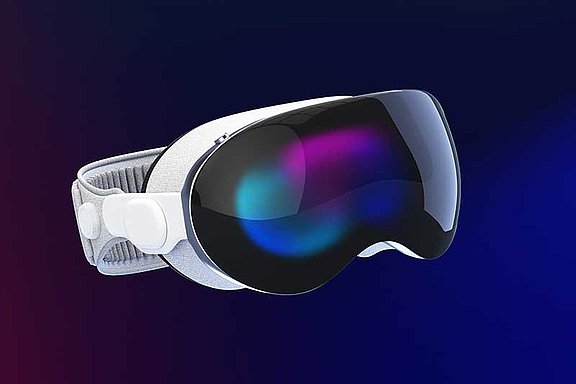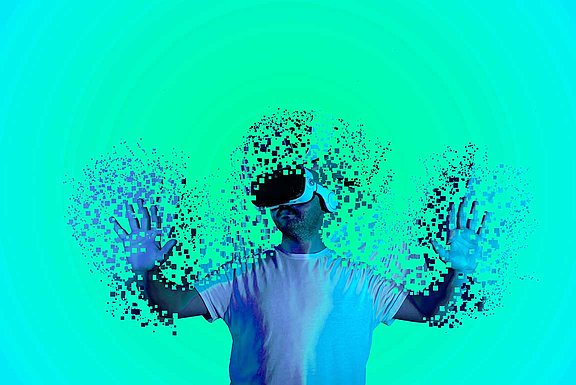Spatial Commerce: The Next Revolution in Retail?
With Apple's Vision Pro, spatial computing could become a mass phenomenon and fundamentally change the way we shop. Find out how Spatial Commerce is bringing the benefits of the virtual world to reality and how companies are already creating cross-channel shopping experiences that will inspire customers in the long term.
What is Spatial Commerce?
Today, consumers can already use AR product configurators to project products as 3D models into their physical environment. Spatial commerce goes a step further by linking virtual reality and augmented reality with current contextual information, from customer locations to inventory levels. The technological building blocks of such spatial commerce experiences are:
- VR or AR-enabled devices such as glasses or smartphones.
- GPS transmitters that document a user's location
- IoT sensors that provide contextual, relevant information about customers, products or inventory
- Cameras that document behavior or produce digital images for further processing
Spatial Commerce and the Apple Vision Pro
Neither AR and VR glasses nor IoT sensors are particularly new technologies. But while AR glasses have long been an important tool in education, machine maintenance, or logistics in many industries, Spatial Commerce is still in its infancy. But with Apple's announcement of the Vision Pro, the vision of hybrid shopping experiences seems closer than ever. In addition to VR goggles, Apple plans a host of important tools to bring VR and AR applications to the mass market. With a software development kit, its own app store, and its own user interface, a lively ecosystem is to be created that is attractive for developers as well as for companies and end customers.

Spatial Commerce: The Future of the Shopping Experience?
With the increasing spread of VR glasses such as the Apple Vision Pro, it makes more and more sense for companies to develop corresponding offers for users of devices such as the Vision Pro. Spatial commerce offers retailers a wide range of opportunities to create new shopping experiences.
- Personal shopping assistants with environmental data: In the future, customers could receive support for their purchasing decisions based not only on their preferences, but also on current environmental data.
- Extended information: Consumers increasingly value transparency regarding product details and manufacturing processes. With the help of augmented reality, companies can provide additional information about their products and specifically enhance the offline shopping experience.
- Smart parking guidance systems: Spatial Commerce could support the development of a smart parking guidance system that identifies available parking spaces near stores in real time and guides customers to a convenient shopping experience.
- Sustainable shopping: Spatial commerce applications could help customers make more environmentally conscious purchases in the future by integrating environmental data such as CO₂ emissions and supply chain information.
- Location-based recommendations: Companies could offer customers contextual information and personalized recommendations via AR glasses during physical shopping.
- Real-time inventory: Companies could use apps to display real-time inventory data to show customers what products are available on site.

This is how Spatial Commerce closes the gap between offline and online commerce
While e-commerce has revolutionized commerce, connecting the online and offline worlds remains a challenge. Spatial Commerce could bridge the gap here and help companies overcome three key challenges:
- Omni-channel experiences: Spatial computing solutions such as AR glasses bridge the gap between online and retail channels, contributing to an immersive and seamless experience. Customers can view and configure products online or in-store, and then view a detailed 3D model of the item at home, right where it will be. This enables a seamless connection between channels and creates a consistent shopping experience along the customer journey.
- Optimal product presentation: Traditionally, the possibilities for product presentation on the Internet have been limited. Customers cannot view products from all sides or physically grasp them. By presenting virtual 3D objects in their own space using AR solutions such as the Combeenation 3D Viewer, companies can present complex products or services interactively and give customers a detailed idea of how they work or can be used.
- Personalization: Colors, designs, functions, materials - the growing desire for personalization on the part of many customers also extends to the products themselves. 70 percent want a personalized shopping experience and to feel that they are taken seriously as people with individual preferences and needs. Augmented reality and 3D configurators allow them to customize products according to their individual preferences.
Spatial Commerce: Get started easy with the Combeenation 3D AR viewer
For a long time, one hurdle in implementing Spatial Commerce was the technical complexity and resource requirements for implementing product configurators or 3D product visualization. With the 3D viewer including AR view, this has changed:
- 3D visualization of products with AR: The 3D viewer enables the display of 3D product visualizations in augmented reality. Customers:can view products in 3D and view them with their smartphone in their home
- No-code: No additional programming is required for use. The 3D model is simply uploaded to the platform. The 3D viewer created can then be easily integrated into websites and online stores.

Conclusion: Spatial Commerce: How to conquer the new space between reality and the digital world
Spatial Commerce offers companies the opportunity to provide innovative and immersive shopping experiences by connecting the digital and physical worlds. By using Augmented-Reality-Technologies, customers can experience products in new ways and make informed purchasing decisions. This strengthens customer loyalty and enables companies to differentiate themselves in a highly competitive market.
And: Getting started with augmented reality today is easier and more affordable than ever before. With the 3D viewer including AR, Combeenation offers you a worldwide unique and uncomplicated possibility to provide your customers with a 3D model in augmented reality and to create cross-channel shopping experiences.
Take the opportunity to explore the new space between reality and the digital world and inspire your customers with a new shopping experience! If you want to know if we are the right partner for you, arrange a short meeting with us.